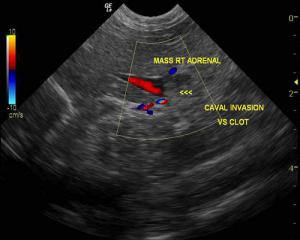Clinical Differential Diagnosis
Pancreatitis, neoplasia, cardiac disease, feline asthma, Heartworm disease, thromboembolic disease causing the respiratory embarassment.
Sonographic Differential Diagnosis
Adrenal adenocarcinoma or pheochromocytoma with caval invasion, less likely benign hyperplasia with caval clot. Lung lesion: lung metastasis, thromboembolism, infammatory consolidation, infectious disease.
Sampling
Post mortem examination revealed right adrenal undifferentiated adenocarcinoma with medullary obliteration and confirmed pulmonary metastasis after histopathological review of the lesions presented here.



Comments